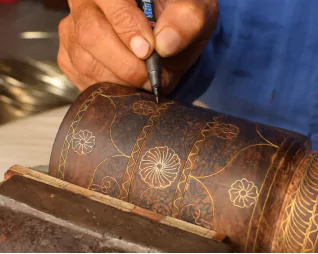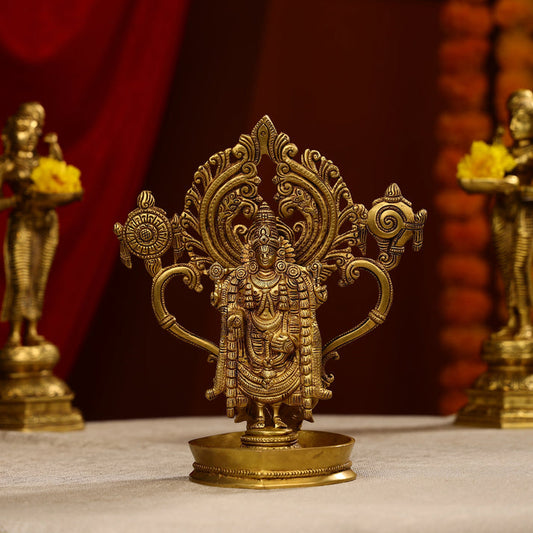The world of handicrafts has numerous art forms that compel you to think, “How is that even possible?”. One such art form is the Tarkashi. If you went out shopping for handicraft items and saw a jewellery box, vase, or wooden plate with intricate, glimmering golden lines, that’s Tarkashi Art. This wire inlay craft demands the steadiest of hands and rightest of strikes to come out beautifully. Tarkashi art is more than just design; it’s a story of patience, precision, and passion passed down through generations.
Let’s dive into the origins and present-day landscape of this art and explore how the skilled artisans turn wood and wire into timeless beauty through an incredible process.
What Is Tarkashi Art?
Taking a look at the literal meaning of Tarkashi art, the word itself is made up of two Hindi words: Taar, meaning “wire,” and Kashi, meaning “inlay.” As the name suggests, this craft involves inlaying fine metal wires into wooden surfaces to create mesmerising designs and patterns. The metal wires usually used for this art are of silver, brass, or copper.
It’s a true blend of craftsmanship and creativity, where every line, curve, and motif is carved by hand. Whether it’s floral motifs, geometric patterns, or traditional jaali designs, each Tarkashi piece carries the artisan’s fingerprint in its detailing.
Keeping Tarkashi Alive: Artisan Communities Of Rajasthan
In the congested streets of Rajasthan, artisan communities like the Mewari and Jangid still practice Tarkashi art and keep the centuries-old tradition alive. The fathers and forefathers of these families have long been engaged in this art and have passed down the skill from generation to generation.
The minute detailing that every artisan carves on the wood is a stroke that preserves heritage in time. Every design, motif, and pattern made using the metal wires carries stories of ancestors who once crafted mesmerising Tarkashi pieces for kings. Many still live in small artisan colonies in Rajasthan, earning recognition for their craft by selling it to digital platforms that display the craft to the world.
The Birthplace of Tarkashi Craft: Its History & Origins
The origins of Tarkashi craft can be traced back to its roots in the royal state of Rajasthan, particularly in the town of Jodhpur. With the passage of time, Udaipur and Alwar have also become hubs where artisans keep this art alive.
Historically, Tarkashi art came to life from the combination of metalwork and woodcarving traditions. The artisans who served in the royal courts combined both the crafts, wood carving and metal inlay, to decorate wooden furniture, jewellery boxes, and even doors of temples and palaces.
With time, this art became a symbol of luxury, grace, and fine Indian taste. And even today, it continues to thrive quietly in the hands of traditional artisans in Rajasthan, keeping centuries of craftsmanship alive.
Where Tarkashi Is Practised Today
While Tarkashi originated in Rajasthan, it’s now also practised in Uttar Pradesh, especially in Mainpuri, where it has even earned a Geographical Indication (GI) tag. This tag officially recognises Mainpuri Tarkashi for its authenticity and craftsmanship, protecting artisans from imitation and ensuring their work gets the value it deserves.
So, whether you come across Tarkashi decor from Jodhpur or a wooden box from Mainpuri, know that both come from a lineage of incredible skill and patience.
The Step-by-Step Process of Tarkashi Art
Tarkashi art is nothing short of meditation as the process demands an immense level of sturdiness, composure, sharp eyes, and patience. Here’s how the sturdy hands of Tarkashi craftsmen bring this magical art to life with every strike.
1. Preparing The Wood
The first step in Tarkashi artwork involves selecting an appropriate wood for the artwork. The artisan selects a piece of Sheesham (Indian rosewood), teak, or walnut wood as these are the most commonly used wood types for this craft. These woods are very durable and can firmly hold the metal wire in their grooves.
2. Designing the Pattern
Once the wood is finalised, the artist planes it lightly if needed and achieves a smooth, even base. The artist then sketches the geometric/floral patterns freehand.
3. Engraving the Grooves
After the design is ready, the artisan uses sharp chisels and pointed tools to cut thin grooves into the wood. This step is very crucial for the Tarkashi artpiece, as even the slightest of misstrikes can ruin the entire design.
4. Inlaying the Metal Wire
This step is what gives this craft its name, “Tarkashi” or wire inlay craft. The artisan then uses thin wires of mild metals like silver, brass, or copper and hammers them into the wooden grooves. The artisan uses tweezers to hold the wire in place and then uses an iron hammer to secure the wire into the design.
5. Smoothing and Polishing
After the wire inlay is complete, the surface is rubbed gently with fine sandpaper to make the metal and wood surface even. Then, it’s polished with wax or natural oils to enhance the shine. The result is an elegant piece that gleams beautifully, catching light in all the right places.
Every Tarkashi item can take days - or even weeks - to complete, depending on its size and complexity. And that’s exactly what makes it priceless.
Materials and Tools Used in Tarkashi
The tools used in Tarkashi art might look simple, but in the hands of skilled artisans, they create wonders.
Common materials include:
- Fine metal wires (silver, brass, copper)
- Wood base (Sheesham, teak, walnut)
- Natural polish or wax
Essential tools include:
- Small chisels and gravers
- Hammer and tweezers
- Files and sandpaper
- Compass and scale for drawing geometric designs
Each tool has its purpose, from carving grooves to embedding and polishing, all handled with care and mastery.
Popular Artefacts Made Using Tarkashi Art
The modern handicraft industry has a wide range of products that are made using Tarkashi art, each of which proves to be a great gift or home decor accent.
- Jewellery boxes and photo frames
- Wall panels and mirror frames
- Chowkis (wooden stands used in rituals)
- Furniture inlays, like cabinet doors or table tops
- Keepsake boxes and key holders
Key Takeaways
Tarkashi art is yet another testament to how culturally rich our Indian heritage is and how well we preserve our traditions. This craft still breathes and evolves in the quiet corners of the bustling streets of Rajasthan. This metal wire craft finds its place in the modern home decor market, which gives a push to the artisan to continue practicing it.
If you are also looking to gift something unique and artistic to your loved ones, there’s no better gift than a Tarkashi artefact. Visit our website and explore our Tarkashi art collection to choose the ones that best fit your gifting purpose.
Frequently Asked Questions
What is Tarkashi art known for?
Tarkashi art is known for its intricate metal wire inlay work on wood, using fine silver, brass, or copper wires to create beautiful patterns and motifs.
Where did Tarkashi art originate?
Tarkashi art originated in Rajasthan, particularly in Jodhpur, and later spread to regions like Udaipur, Alwar, and Mainpuri in Uttar Pradesh, which now holds a GI tag for it.
Which metals wires are used for inlay in Tarkashi craft?
The most commonly used metal wires in Tarkashi art are made of brass, copper, or silver. These wires are secured into the wooden grooves with the help of a hammer.
How much time does an artisan take to finish a Tarkashi artefact?
The time taken to complete a Tarkashi artwork depends entirely on the size of the artefact and the design complexity. It can take anywhere between several days and weeks to complete a single Tarkashi design due to its detailed handwork.
Why should I buy Tarkashi handicrafts?
Owning Tarkashi art means owning a piece of India’s cultural heritage. Each artefact is handmade, timeless, and makes a meaningful addition to your home or gift collection.



